
In relation to the portrayal of sisterhood in Disney, they don’t just show sisterly relationships where they’re close in age and follow the typical path, there is variety. There are non-biological sibling relationships, as well as dynamics where a sibling has to take on the parental role. All of which deserve recognition and analysis.
Cinderella, Anastasia & Drizella: Cinderella (1950)
Arguably one of the most iconic and historic Disney sibling dynamics is also one of the most toxic.
Cinderella and her step-sisters created the foundations of a fairytale stereotype that follows abuse and power imbalance in a blended family, especially when one member is severely outnumbered or outspoken. This story is also the basis of the narrative that many criticise Disney for, in that it took Cinderella marrying a Prince to rescue her from her sad life.
The abuse against Cinderella can be blamed on Lady Tremaine, as she started the pattern, and encouraged her biological daughters, Anastasia and Drizella, to do the same. Of course, there are real relationships where this type of thing happens in the real world, however, the qualm with Disney is that there have not been any other blended-family dynamics since, and so that has become the precedent set.
When looking at the sisterhood dynamics of Cinderella with Anastasia and Drizella, there is a very clear sentiment of “good vs bad,” meaning “pretty vs ugly.” It could be an example of siblings being pitted against each other by an adult, or perhaps it’s really just the typical device of a fairytale, wherein the differences between right and wrong are exaggerated.
Either way, the original film is an example set of a step-sibling relationship that was one of the fairytale stereotypes and vain caricatures (given the overall character designs, but that’s a different essay). The blended sisterhood dynamic shown in Cinderella is one where girls were pitted against each other as children, and that blood connection meant that Cinderella, as the “outsider,” was the least valued. For Anastasia and Drizella, their treatment of their step-sister may have been the impact of their cruel mother’s teachings.
As a sisterly relationship, Cinderella with Anastasia and Drizella is distorted and imbalanced, and provides as an example of a toxic family dynamic, within a classical princess story, where beauty and kindness reap all reward at the end of the day.
Nani & Lilo: Lilo & Stitch (2002)
Following the loss of their parents, Nani put her dreams on hold and took it upon herself to give her little sister, Lilo the best upbringing. There are many challenges on the path to achieving this; like the possibility of losing the house, and being separated by children’s service agents.
Nani is presented as the responsible parental figure in Lilo’s life, who supports her sister as well as her imagination and dreams, no matter how out-there and they can get. Because of her young age, Lilo may not completely understand what Nani has sacrificed to keep their family together, but she is clearly appreciative, despite the times where there are friction and frustration between the sisters.
Both girls are in different points of their girlhood, and therefore, may experience things very differently, Nani becomes overwhelmed and stressed, whereas Lilo maintains her positive outlook for as long as she can when they’re faced with tough situations. Their love and need to keep what family they have left together is the driving force in Nani’s nature, and the driving force in Lilo wishing upon an angel for hope. Even though that angel ended up coming in the form of a chaotic alien named Stitch.
Family, whether biological or not, are the driving message of the film, and it is mostly explored from the child-perspective, in that Lilo is shielded from the pressure that Nani must be feeling, to some extent. Lilo can’t work to help Nani pay the bills and keep the house, but what Lilo can do is hope, no matter how hard it is.
In the end, Stitch finds the people to call his family, whilst Lilo and Nani find that their sisterly connection has strengthened, with the overall message being about the value of “Ohana” and finding a family.
-Emily Rawle
Junior Girl
Girl Museum Inc.
